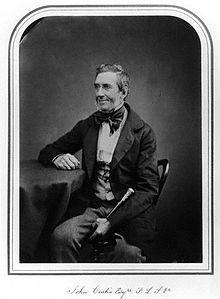John Curtis (entomologist)
| John Curtis | |
|---|---|

John Curtis 1855
|
|
| Born |
September 3, 1791 Norwich, Norfolk, East of England |
| Died | October 6, 1862 (aged 71) |
| Known for | Entomology |
John Curtis (3 September 1791 – 6 October 1862) was an English entomologist and illustrator.
Curtis was born in Norwich and learned his engraving skills in the workshop of his father, Charles Morgan Curtis. Charles Curtis died young and his widow, Frances, became a flower grower.She encouraged her son to study natural history with a local naturalist, Richard Walker (1791–1870). At the age of 16 he became an apprentice at a local lawyer's office in Norwich but devoted his spare time to studying and drawing insects and, with insect collecting becoming a growing craze, he found he could make a living selling the specimens he found. At this time he became a friend of Simon Wilkin (1790–1862), finally leaving his job and living with Wilkin at Costessey where he undertook systematic insect studies. Through Wilkin he met the entomologists William Kirby and William Spence and his illustrations were published in An Introduction to Entomology (1815–1826).
Sometime between 1817 and 1819 Curtis moved to London, meeting Sir Joseph Banks, president of the Royal Society. Banks introduced him to William Elford Leach a curator at the British Museum.He studied conchology with Leach. Through Leach he met James Charles Dale who became his patron.He also worked in Paris with Pierre André Latreille.
In 1824 he began his greatest achievement, British Entomology - being illustrations and descriptions of the genera of insects found in Great Britain and Ireland, widely considered one of the finest works on the subject of the nineteenth century. It was published in monthly parts by subscription from 1824 to 1839, each part comprising 3 or more plates with descriptive texts ranging from usually 2 to as many as 10 pages. The finished work comprised 16 volumes each of 12 parts, 192 parts in all together with 770 plates (1 to 769 plus 205*), available either coloured or plain. Georges Cuvier (1769–1832) described British Entomology as "the paragon of perfection".
...
Wikipedia
